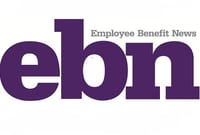 Initiatives by employers to drive up savings and enrollment in their retirement plans over the past decade have generally followed the same three-pronged approach — participate, save, diversify.
Initiatives by employers to drive up savings and enrollment in their retirement plans over the past decade have generally followed the same three-pronged approach — participate, save, diversify.
- Participate: Automatically enrolling new employees;
- Save: Raising plan matches and/or enabling participants to automatically increase deferrals;
- Diversify: Offering target-date funds or managed accounts to better diversify participants’ portfolios.
By adding a fourth component – consolidate – to the script, plan sponsors can improve their success metrics, help employees achieve better retirement outcomes and reduce the number of costly small accounts in their plan. Consolidation actively encourages employees to roll in their prior employer retirement account balances to the current plan at the beginning of employment.
The new script — participate/consolidate/save/diversify — promises to deliver even better outcomes for both plans and their participants.
The average American worker will change jobs 7.4 times over the course of a 40-year career, according to the Employee Benefit Research Institute, meaning that nearly 10 million participants in U.S. defined contribution plans change jobs every year. Today’s mobile workforce has led to a continuously growing pool of small accounts in 401(k) plans — EBRI estimates that 39.6% of 401(k) account balances contained, on average, less than $10,000 in 2012.
Most of these small accounts are stranded by participants in their former employers’ retirement plans, creating higher administration costs and liabilities for plan sponsors. Although the vast majority of sponsored plans have a roll-in provision, only 0.5% of participants actually transferred their savings into their new employers’ plans in 2012, according to EBRI.
A case study outlined in an April 2013 report from Boston Research Group demonstrates the impressive changes that roll-in solutions can generate. The report focused on a large, multi-regional U.S. healthcare provider with more than 190,000 employees. The company consistently experienced 20-23% annual turnover — which resulted in many stranded small-balance accounts, uncashed checks and lost/missing participant accounts. Between 40% and 56% of former employees cashed out their 401(k) accounts every year from 2002-2006, and 16-18% of total account balances were cashed out annually during the same time period.
After implementing an assisted roll-in program which offered all new and existing employees the opportunity to transfer their IRA and previous DC plan balances into the company’s plan — as well as automatic and assisted rollover programs to consolidate accounts from departing employees — the firm was able to reduce 401(k) cashouts by 52%. In addition, the assisted roll-in program helped participants consolidate 72,006 accounts totaling $2.04 billion in assets into existing retirement accounts. Moreover, the program saved more than $6 million in recordkeeping, custody and administration fees, and increased the plan’s average account balance, a key metric for measuring plan success, by 57.8%.
The traditional participate/save/diversify approach to improving plan metrics has been effective, but as Boston Research Group’s case study shows, sponsors can achieve dramatically better results if they add “consolidate” to that formula.
Like plan enrollment and investment selection, with portability it’s best to eschew the DIY route.
